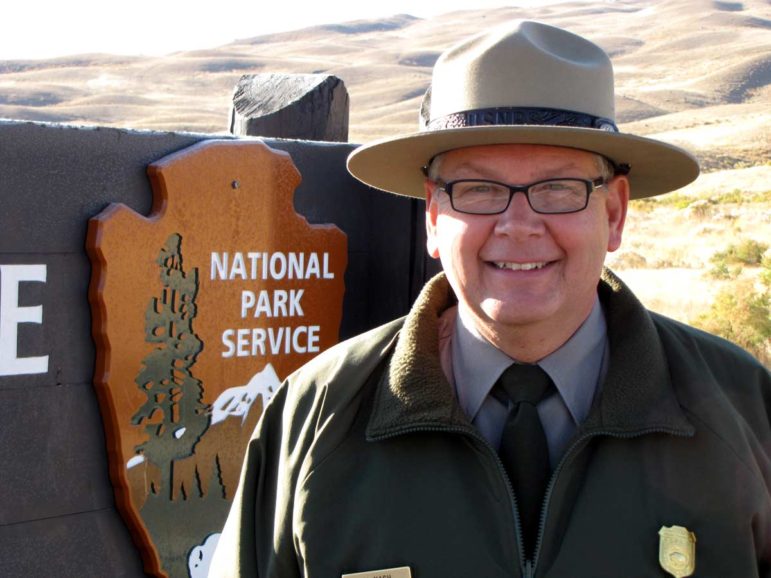
One of the first things Al Nash can remember about Yellowstone National Park is the smell.
“I remember how stinky it was—that sulfur smell,” Nash said, recalling a trip to Yellowstone with his parents when he was a young child, more than 50 years ago.
“I remember my mom shooing my sister and I into the car while my dad was trying to get a photo of a black bear in a pull-out,” he said.
Those early Yellowstone memories came flooding back this month as Nash, the chief of public affairs for Yellowstone since 2006, reflected on nearly a decade in that role just before his last day on the job March 18.
“It’s the longest I’ve lived in one place, and the longest I’ve ever held one job,” said Nash, who left Mammoth Hot Springs and the National Park Service for a job in Billings, Mont. as the new chief of communication for the Montana/Dakotas office of the U.S. Bureau of Land Management.
The last nine years have seen sweeping changes in how the public finds and shares information about everything, including national parks.
Nash said the rise of social media drastically changed his job. Facebook, Twitter, Instagram and other online platforms were not dominant information channels a decade ago. Drones—unmanned aerial vehicles equipped with tiny, high-definition cameras—went from secret Pentagon technology to consumer gadget over that same period.
“The advent of all this new technology has allowed for a more rapid information flow,” Nash said. “But that makes our job more complicated than it once did.”
With Yellowstone often at the center of a new or long-simmering public policy controversy, public affairs now often involves monitoring and responding to a seemingly infinite flow of real-time, online digital information streams.
For Nash, much of his work has involved, as he diplomatically puts it, “working with people who may have an incomplete understanding of Yellowstone and how the park operates.”
Explosive rumors
All too often, that has included “people out there who are convinced that Yellowstone is going to explode at any moment, and that we are keeping that fact from them.”
Public fascination with the Yellowstone supervolcano has been steady, or even increased, during Nash’s tenure, with many people fixating on erroneous rumors of imminent eruptions.
Another challenge has been what Nash described as “the ongoing issue we have in helping visitors understand that (Yellowstone’s) wild animals are truly wild, and that they are visiting a wild environment.”
“I frankly wonder if our challenges in that area aren’t getting greater over time now, simply because visitors today have less experience with wild, large animals than visitors may have had 30 years go,” he said.
Perhaps the biggest step forward for Yellowstone during Nash’s time in public affairs has been resolving the dispute over winter use. This past winter saw the first season operating under a newly adopted plan to manage snowmobile and snow coach travel, after more than a decade of lawsuits and public controversy.
“We felt it was a very good first year” under the new plan, Nash said. Park officials may make “some small adjustments” before next winter, but the biggest challenge was a lack of snow at times, especially between West Yellowstone, Mont. and Old Faithful, Nash said.
Looking ahead, Nash sees a few issues that are likely to be near the top of his successor’s priority list.
“Bison management has been even more challenging than winter use,” Nash said, and the issue has no likely easy fix on the horizon.
“There are those who have a naive perception that we can either be entirely hands-off or that we’re going to ‘ranch” the bison herd,” Nash said. “The park needs to continue to engage them so they realize both of those points of view are not realistic.”
Growing crowds of diverse visitors seeking increasingly complex services will be “a continuing challenge for park staff, and for my successors,” he said.
“Issues and discussions bout climate change are going to take on an ever-increasing role” in public discourse about Yellowstone, Nash said.
Lake favorites
Nash said his favorite part of Yellowstone is the Lake area, where he started his tenure with the Park Service in 1995 as a seasonal ranger-naturalist at Fishing Bridge.
“Whether it’s a quick hike out to Storm Point or something more daunting like a hike up to Avalanche (Peak), or just standing there on Fishing Bridge at sunset, there’s just something especially magical to me about that part of the park,” he said.
The move back to Billings, where Nash worked previously as a broadcast journalist, was partly because he had “begun to feel a bit stale when writing the same news release for the ninth time.”
But it was also a chance, he said, to enjoy some of the amenities and conveniences of a larger city that simply don’t exist in Mammoth or Gardiner, Mont.
“But just because I won’t be living and working here doesn’t mean that my passion for this place fades,” Nash said, his voice breaking with emotion.
Being the public face of Yellowstone during a wide range of hotly contested issues “was not always easy and not always fun, but it has been consistently rewarding,” he said.
Contact Ruffin Prevost at 307-213-9818 or [email protected].
